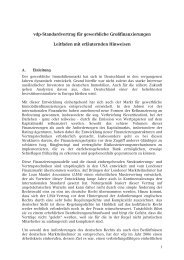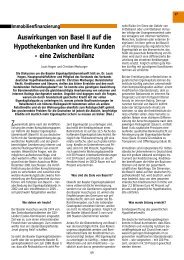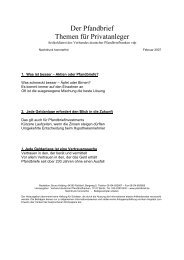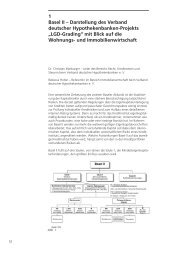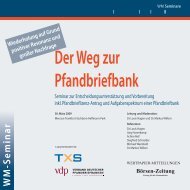The Pfandbrief 2011 | 2012
The Pfandbrief 2011 | 2012
The Pfandbrief 2011 | 2012
You also want an ePaper? Increase the reach of your titles
YUMPU automatically turns print PDFs into web optimized ePapers that Google loves.
waiving exemption from retroactive application for purposes of solvency in specific cases)<br />
and<br />
increase privileged risk-weights conditional to domestic loan loss and default histories in<br />
EU member states warranting such measures.<br />
If actually implemented, all of these amendments could lead to a further increase in required<br />
regulatory capital.<br />
Introduction of a maximum leverage ratio<br />
Given the recent experience from the financial crisis, the regulatory maximum leverage ratio<br />
stipulated in the Basel III framework was designed to put a definitive end to the build-up of<br />
excessive debt in the banking sector, thereby preventing painful deleveraging processes in the<br />
real economy in crisis situations. <strong>The</strong> leverage ratio (LR) is intended to act as an additional<br />
backstop measure to supplement the risk-sensitive capital requirements of the Basel regulations.<br />
According to CRD IV, the leverage ratio will initially be implemented at the beginning of<br />
2013 as an observation ratio as part of the bank regulatory review process under Pillar II of the<br />
Basel framework. During the first half of 2017, the last year of the observation phase, an analysis<br />
will determine whether a mandatory leverage ratio unreasonably burdens individual business<br />
models and/or credit transactions, and a decision will be made as to whether it should<br />
remain in Pillar II as an observation ratio or be moved to Pillar I as a mandatory regulatory<br />
ratio. At the same time, an early, firm commitment by politicians as to which direction the process<br />
should take will be crucial for avoiding the undesirable strategic positioning on the part of<br />
the banking industry that is already expected to start soon. <strong>The</strong> leverage ratio is defined as<br />
33<br />
Leverage Ratio =<br />
Capital measure<br />
Exposure measure<br />
Basel III rules call for a minimum leverage ratio of 3%, subject however to final calibration.<br />
A corresponding qualification applies to the specific definition of the leverage ratio, as well<br />
as to the capital measure in the numerator and the exposure measure in the denominator.<br />
Based on the existing definition in the Basel III framework, the capital measure in the<br />
numerator is determined by the Tier 1 capital (in accordance with Basel III). As an alternative,<br />
during the course of the Basel III implementation at the EU level, consideration will be given<br />
to limiting this to common equity Tier 1 capital. In line with the relevant amounts set forth in<br />
the solvency regulations, the exposure measure encompasses on-balance-sheet assets, derivatives<br />
and off-balance-sheet transactions. On-balance-sheet assets are regularly reported at the<br />
respective book value; for derivatives, the stated value is determined using the mark-to-market<br />
method (already laid down in the solvency regulations).<br />
It should be noted that no credit-risk mitigants (e.g., securities collateral, mortgages, guarantees)<br />
may be used to reduce the exposure measure of the hedged underlying transaction.<br />
<strong>The</strong> only exception to this under the Basel III regulations is for certain netting agreements,<br />
especially involving derivatives transactions.




